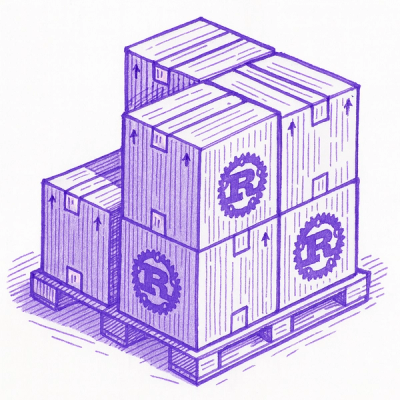
Security News
Open Source Maintainers Feeling the Weight of the EU’s Cyber Resilience Act
The EU Cyber Resilience Act is prompting compliance requests that open source maintainers may not be obligated or equipped to handle.
svelte-cartesian
Advanced tools
A single component that helps render prop combinations (the "Cartesian Product") for visual regression testing.
A single component that helps render prop combinations (the "Cartesian Product") for visual regression testing.

When building reusable components, testing them helps build confidence that they'll work as expected in one or many consuming applications, and helps ensure they remain stable as features are added. This includes, but is not limited to:
At various stages of a UI library's maturity, different levels of test coverage become more necessary as the library matures.
svelte-cartesian helps with point 4: Visual regression tests. Today, rendering
many combinations of a component requires nested {#each} loops and some style
boilerplate. svelte-cartesian solves this in one component that accepts prop
values you wish to test, and then renders prop combinations.
svelte-cartesiansvelte-cartesian<script>
import { Button } from './Button.svelte'
</script>
<!-- This nests deeper with every additional prop -->
{#each ['primary', 'secondary'] as variant}
{#each ['small', 'medium', 'large'] as size}
{#each ['main', 'common', 'ghost'] as prominence}
<Button {size} {variant} {prominence}>
Dispense popcorn
</Button>
{/each}
{/each}
{/each}
svelte-cartesian<script>
import { Cartesian } from 'svelte-cartesian'
import { Button } from './Button.svelte'
</script>
<Cartesian
Component={Button}
props={{
variant: ['primary', 'secondary'],
size: ['small', 'medium', 'large'],
prominence: ['main', 'common', 'ghost']
}}
>
Dispense popcorn
</Cartesian>
Install package
npm install -D svelte-cartesian
Add component to your page.
<script>
import { Cartesian } from 'svelte-cartesian'
</script>
Pass props with array of potential values, including an explicit undefined
where applicable.
Component prop.props containing possible prop keys for your passed-in
component, with each prop key containing an array of potential values.<script>
import Button from './Button.svelte'
import { Cartesian } from 'svelte-cartesian'
</script>
<Cartesian
Component={Button}
props={{
variant: ['primary', 'secondary'],
size: ['medium', 'large']
}}
>
Click me
</Cartesian>
innerProps slot prop to your component, which will render a
single prop combination at every iteration.<script>
import Button from './Button.svelte'
import { Cartesian } from 'svelte-cartesian'
const props = {
Component: Button,
props: {
variant: ['primary', 'secondary'],
size: ['medium', 'large']
}
}
</script>
<!-- Left slot + default slot -->
<Cartesian {...props} let:innerProps>
<Button {...innerProps}>
<svelte:fragment slot="left">
Left contents
</svelte:fragment>
Click me
</Button>
</Cartesian>
<!-- Default slot on its own -->
<Cartesian {...props} let:innerProps>
<Button {...innerProps}>
Click me
</Button>
</Cartesian>
Use the labels prop to generate labels next to every component instance.
<Cartesian
props={props}
Component={Component}
labels />
<!-- ^^^^^^ implied as `true` -->
Allowed values for the labels prop:
true: same as 'short'.'short': display comma-separated values, skip objects.'long': display line-separated key-value pairs, represent object values as their type name.'long-with-objects': same as 'long', but with full object definitions.Default labelling behaviour can be overridden with the label slot.
<!-- Using `label` slot prop -->
<Cartesian
props={props}
Component={Component}
labels
>
<div class="label-container" slot="label" let:label>
<span class="label">Props</span>
<pre class="props">{label}</pre>
</div>
</Cartesian>
<!--
Using `innerProps` slot prop.
Note: `label` prop isn't required when
using `innerProps` to render labels.
-->
<Cartesian
props={props}
Component={Component}
>
<div class="label-container" slot="label" let:innerProps>
<span class="label">Props</span>
<pre class="props">{customLabel(innerProps)}</pre>
</div>
</Cartesian>
<Cartesian> (Svelte 4)<Cartesian> has these default CSS behaviours:
gap of 1rem.padding is set to 0.5rem 1rem to allow consistent space when multiple
<Cartesian> components are rendered one after the other.grid-template-columns is set to var(--columns, repeat(2, 1fr)) for a
default 2-column grid overridable with the --columns CSS variable.There are a few ways to override its styles:
--columns CSS variable; you may use Svelte --style-props or
style="--columns: repeat(3, 1fr)" to set a new value.style attribute that overrides the default style via
divAttributes. The same technique can be applied to your own passed-in
components so long as it accepts style via $$restProps or pass-through props.class attribute that gets passed in via divAttributes.<Cartesian> with your own element and styles, and set the unstyled
prop to true.<script>
import { Cartesian } from 'svelte-cartesian'
import Button from './Button.svelte'
</script>
<Cartesian
Component={Button}
props={{
size: ['small', 'medium'],
variant: ['primary', 'secondary']
}}
--columns="repeat(4, 1fr)"
style="background-color: green"
> <!-- customize style -->
</Cartesian>
<Cartesian> props (Svelte 4)| prop | type | description |
|---|---|---|
Component | ComponentType | Required: A Svelte component. |
props | Record<string, any[]> | Required: An object containing prop names and an array of potential values. |
asChild | ?boolean=false | Renders the default slot's contents. Each Cartesian's iteration will pass innerProps as slot props. Default value false. See usage with slots for more details. |
labels | ?(undefined | boolean | 'short' | 'long' | 'long-with-objects')=undefined | Generate labels under every iteration. See adding labels for detailed usage. |
unstyled | ?boolean=false | Disable built-in CSS. |
divAttributes | ?SvelteHTMLElements["div"]={} | Attributes to be spread onto the wrapping <div> element. |
let:innerProps | Record<string, any> | Provides a single combination of props at every iteration to the default slot. Use this alongside asChild to spread innerProps to your nested component. |
let:label | string | Generated label for a given instance. This is provided to the label slot. See adding labels for more details. |
<Cartesian> slots (Svelte 4)| slot name | slot props | description |
|---|---|---|
| default | let:innerProps | Default slot. Contents get passed to provided Component. When asChild is set to true, contents MAY contain provided Component and its respective slots; see usage with slots for more details. |
label | let:label, let:innerProps | Provide your own label, styles, and logic instead of the default provided label. |
See more examples in end to end tests.
[!WARNING] This component is based on the release candidate of Svelte 5 and is considered unstable. Any breaking changes will not be properly indicated in
svelte-cartesianreleases at this time, but there are no planned changes.
Install package
npm install -D svelte-cartesian
Add component to your page.
<script>
import Button from './Button.svelte'
import { CartesianWithRunes as Cartesian } from 'svelte-cartesian'
</script>
{#snippet children()}
Click me
{/snippet}
<Cartesian
Component={Button}
props={{
variant: ['primary', 'secondary'],
size: ['medium', 'large'],
children: [children]
}}
/>
Pass props with array of potential values, including an explicit undefined
where applicable. Ensure snippets are passed in as props and defined within
the markup of the page using <CartesianWithRunes>.
<CartesianWithRunes> (Svelte 5)Styling <CartesianWithRunes> is done in the exact same way as with <Cartesian>.
<CartesianWithRunes> props (Svelte 5)| prop | type | description |
|---|---|---|
Component | ComponentType | Required: A Svelte component. |
props | Record<string, any[]> | Required: An object containing prop names and an array of potential values. |
unstyled | ?boolean=false | Disable built-in CSS. |
divAttributes | ?SvelteHTMLElements["div"]={} | Attributes to be spread onto the wrapping <div> element. |
getCartesianProduct() upon request.FAQs
A single component that helps render prop combinations (the "Cartesian Product") for visual regression testing.
The npm package svelte-cartesian receives a total of 42 weekly downloads. As such, svelte-cartesian popularity was classified as not popular.
We found that svelte-cartesian demonstrated a healthy version release cadence and project activity because the last version was released less than a year ago. It has 0 open source maintainers collaborating on the project.
Did you know?

Socket for GitHub automatically highlights issues in each pull request and monitors the health of all your open source dependencies. Discover the contents of your packages and block harmful activity before you install or update your dependencies.

Security News
The EU Cyber Resilience Act is prompting compliance requests that open source maintainers may not be obligated or equipped to handle.

Security News
Crates.io adds Trusted Publishing support, enabling secure GitHub Actions-based crate releases without long-lived API tokens.

Research
/Security News
Undocumented protestware found in 28 npm packages disrupts UI for Russian-language users visiting Russian and Belarusian domains.